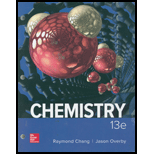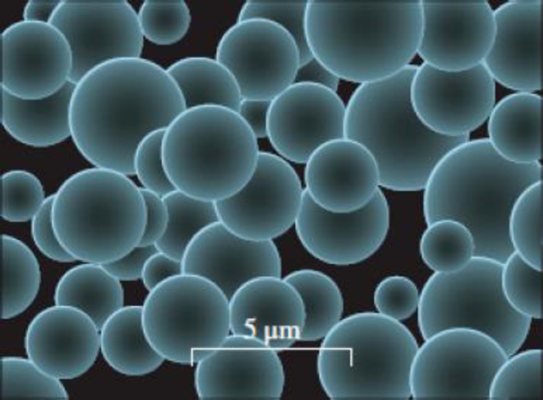
CHEMISTRY (LOOSELEAF) >CUSTOM<
13th Edition
ISBN: 9781264348992
Author: Chang
Publisher: MCGRAW-HILL HIGHER EDUCATION
expand_more
expand_more
format_list_bulleted
Concept explainers
Textbook Question
Chapter 2, Problem 2.122QP
One technique proposed for recycling plastic grocery bags is to heat them at 700°C and high pressure to form carbon microspheres that can be used in a number of applications. Electron microscopy shows some representative carbon microspheres obtained in this manner, where the scale is given in the bottom right corner of the figure. Determine the number of carbon atoms in a typical carbon microsphere.

Expert Solution & Answer
Want to see the full answer?
Check out a sample textbook solution
Students have asked these similar questions
Using Benzene as starting materid show
how each of the Following molecules Contel
Ve syntheswed
CHI
9.
b
-50311
с
CHY
503H
Ночто
d.
อ
•NOV
e
11-0-650
NO2
The molecule PYRIDINE,
6th electrons and is therefore aromatre
and is Assigned the Following structure
contering
Since aromatk moleculoy undergo electrophilic
anomatic substitution, Pyridine shodd undergo
The Following reaction
+ HNO3
12504
a. write all of the possible Mononitration Products
that could Result From this reaction
18. Bared upon the reaction mechanison determime
which of these producty would be the major
Product of the hegetion
a. Explain Why electron withdrawing groups
tend to be meta-Directors. Your answer Should
lyclude all apropriate. Resonance contributing
Structures
fo. Explain why -ll is an outho -tura
drccton even though chlorine has a very High
Electronegativity
Chapter 2 Solutions
CHEMISTRY (LOOSELEAF) >CUSTOM<
Ch. 2.1 - The atoms of elements A (blue) and B (orange) form...Ch. 2.3 - How many protons, neutrons, and electrons are in...Ch. 2.3 - What is the atomic number of an element if one of...Ch. 2.3 - How many neutrons are in an atom of 114Cd?Ch. 2.3 - Which of the following two symbols provides more...Ch. 2.4 - In viewing the periodic table, do chemical...Ch. 2.4 - Identify the following as a metal, metalloid, or...Ch. 2.5 - What does S8 signify? How does it differ from 8S?Ch. 2.5 - Determine the number of protons and electrons for...Ch. 2.5 - Prob. 3RCF
Ch. 2.6 - Write the empirical formula for caffeine...Ch. 2.6 - Prob. 4PECh. 2.6 - Prob. 1RCFCh. 2.6 - Prob. 2RCFCh. 2.7 - Name the following compounds: (a) PbO and (b)...Ch. 2.7 - Prob. 6PECh. 2.7 - Name the following molecular compounds: (a) NF3...Ch. 2.7 - Prob. 8PECh. 2.7 - Prob. 9PECh. 2.7 - Prob. 1RCFCh. 2.7 - Prob. 2RCFCh. 2.7 - Prob. 3RCFCh. 2.7 - Prob. 4RCFCh. 2.7 - Prob. 5RCFCh. 2.8 - Prob. 1RCFCh. 2 - Prob. 2.1QPCh. 2 - Name the types of radiation known to be emitted by...Ch. 2 - Compare the properties of the following: ...Ch. 2 - What is meant by the term fundamental particle?Ch. 2 - Describe the contributions of the following...Ch. 2 - Describe the experimental basis for believing that...Ch. 2 - The diameter of a helium atom is about 1 102 pm....Ch. 2 - Prob. 2.8QPCh. 2 - Use the helium-4 isotope to define atomic number...Ch. 2 - Why do all atoms of an element have the same...Ch. 2 - What do we call atoms of the same elements with...Ch. 2 - Explain the meaning of each term in the symbol...Ch. 2 - What is the mass number of an iron atom that has...Ch. 2 - Calculate the number of neutrons in 239Pu.Ch. 2 - Prob. 2.15QPCh. 2 - Indicate the number of protons, neutrons, and...Ch. 2 - Write the appropriate symbol for each of the...Ch. 2 - Write the appropriate symbol for each of the...Ch. 2 - What is the periodic table, and what is its...Ch. 2 - State two differences between a metal and a...Ch. 2 - Write the names and symbols for four elements in...Ch. 2 - Define, with two examples, the following terms:...Ch. 2 - Prob. 2.23QPCh. 2 - Describe the changes in properties (from metals to...Ch. 2 - Consult a handbook of chemical and physical data...Ch. 2 - Group the following elements in pairs that you...Ch. 2 - Prob. 2.27QPCh. 2 - Prob. 2.28QPCh. 2 - Describe the two commonly used molecular models.Ch. 2 - Prob. 2.30QPCh. 2 - Prob. 2.31QPCh. 2 - Prob. 2.32QPCh. 2 - Identify the following as elements or compounds:...Ch. 2 - Prob. 2.34QPCh. 2 - Give the number of protons and electrons in each...Ch. 2 - Give the number of protons and electrons in each...Ch. 2 - Pair the following species that contain the same...Ch. 2 - Write the correct symbols for the atoms that...Ch. 2 - What does a chemical formula represent? What is...Ch. 2 - Define molecular formula and empirical formula....Ch. 2 - Give an example of a case in which two molecules...Ch. 2 - Prob. 2.42QPCh. 2 - Prob. 2.43QPCh. 2 - Prob. 2.44QPCh. 2 - Prob. 2.45QPCh. 2 - Prob. 2.46QPCh. 2 - What are the empirical formulas of the following...Ch. 2 - What are the empirical formulas of the following...Ch. 2 - Write the molecular formula of glycine, an amino...Ch. 2 - Write the molecular formula of ethanol. The color...Ch. 2 - Prob. 2.51QPCh. 2 - Prob. 2.52QPCh. 2 - Prob. 2.53QPCh. 2 - Prob. 2.54QPCh. 2 - Prob. 2.55QPCh. 2 - Prob. 2.56QPCh. 2 - Prob. 2.57QPCh. 2 - Prob. 2.58QPCh. 2 - Name these compounds: (a) Na2CrO4, (b) K2HPO4, (c)...Ch. 2 - Prob. 2.60QPCh. 2 - Prob. 2.61QPCh. 2 - Prob. 2.62QPCh. 2 - Sulfur (S) and fluorine (F) form several different...Ch. 2 - Prob. 2.64QPCh. 2 - Prob. 2.65QPCh. 2 - In which one of the following pairs do the two...Ch. 2 - Prob. 2.67QPCh. 2 - Prob. 2.68QPCh. 2 - Determine the molecular and empirical formulas of...Ch. 2 - What is wrong with or ambiguous about the phrase...Ch. 2 - Prob. 2.71QPCh. 2 - Which of the following are elements, which are...Ch. 2 - Prob. 2.73QPCh. 2 - Prob. 2.74QPCh. 2 - Each of the following pairs of elements will react...Ch. 2 - Match the descriptions [(a)(h)] with each of the...Ch. 2 - Explain why anions are always larger than the...Ch. 2 - Prob. 2.78QPCh. 2 - Caffeine, shown here, is a psychoactive stimulant...Ch. 2 - Prob. 2.80QPCh. 2 - Prob. 2.81QPCh. 2 - Prob. 2.82QPCh. 2 - Fill in the blanks in the following table.Ch. 2 - Prob. 2.84QPCh. 2 - Write the formula of the common ion derived from...Ch. 2 - Prob. 2.86QPCh. 2 - Prob. 2.87QPCh. 2 - Of the 118 elements known, only two are liquids at...Ch. 2 - Prob. 2.89QPCh. 2 - Prob. 2.90QPCh. 2 - Prob. 2.91QPCh. 2 - Prob. 2.92QPCh. 2 - Prob. 2.93QPCh. 2 - Prob. 2.94QPCh. 2 - List five elements each that are (a) named after...Ch. 2 - Prob. 2.96QPCh. 2 - Fluorine reacts with hydrogen (H) and deuterium...Ch. 2 - Prob. 2.98QPCh. 2 - Identify each of the following elements: (a) a...Ch. 2 - Prob. 2.100QPCh. 2 - Show the locations of (a) alkali metals, (b)...Ch. 2 - Fill the blanks in the following table.Ch. 2 - Prob. 2.103QPCh. 2 - In Section 2.1 it was pointed out that mass and...Ch. 2 - Draw all possible structural formulas of the...Ch. 2 - Prob. 2.106QPCh. 2 - Draw two different structural formulas based on...Ch. 2 - Prob. 2.108QPCh. 2 - Prob. 2.109QPCh. 2 - A monatomic ion has a charge of +2. The nucleus of...Ch. 2 - In the following 2 2 crossword, each letter must...Ch. 2 - Prob. 2.112QPCh. 2 - Prob. 2.113QPCh. 2 - Prob. 2.114QPCh. 2 - Prob. 2.115QPCh. 2 - Prob. 2.116QPCh. 2 - Prob. 2.117QPCh. 2 - Prob. 2.118QPCh. 2 - Prob. 2.119QPCh. 2 - Prob. 2.120QPCh. 2 - Prob. 2.121QPCh. 2 - One technique proposed for recycling plastic...
Knowledge Booster
Learn more about
Need a deep-dive on the concept behind this application? Look no further. Learn more about this topic, chemistry and related others by exploring similar questions and additional content below.Similar questions
- 9. Write Me product as well as the reaction Mechanism For each of the Following Vanctions +H₂504 4.50+ T C. +212 Fellz 237 b. Praw the potential energy Diagrams For each OF Mese Rauctions and account For any differences that appear in the two potential Puergy Diagrams which of here two reactions 19 Found to be Reversable, Rationalice your answer based upon the venation mechanisms and the potential energy diagrams.arrow_forward9. Write Me product as well as the reaction Mechanism For each of the Following Veritious +H2504 4.50+ + 1/₂ Felly ◎+ 7 b. Praw he potential energy Diagrams For each OF Mese Ronctions and account for any differences that appeak in the two potential Puergy Diagramsarrow_forwardDraw the major product of this reaction. Ignore inorganic byproducts. Incorrect, 3 attempts remaining 1. excess Br2, NaOH 2. neutralizing workup Qarrow_forward
- Given the electrode Pt | Ag | Ag+ (aq), describe it.arrow_forwardAt 25°C, the reaction Zn2+ + 2e ⇄ Zn has a normal equilibrium potential versus the saturated calomel electrode of -1.0048 V. Determine the normal equilibrium potential of Zn versus the hydrogen electrode.Data: The calomel electrode potential is E° = 0.2420 V versus the normal hydrogen electrode.arrow_forwardElectrochemistry. State the difference between E and E0.arrow_forward
- In an electrolytic cell, the positive pole is always assumed to be on the right side of the battery notation. Is that correct?arrow_forwardIn an electrolytic cell, the positive pole is always assumed to be on the right side of the battery. Is that correct?arrow_forwardCalculate the free energy of formation of 1 mol of Cu in cells where the electrolyte is 1 mol dm-3 Cu2+ in sulfate solution, pH 0. E° for the Cu2+/Cu pair in this medium is +142 mV versus ENH.Assume the anodic reaction is oxygen evolution.Data: EH2 = -0.059 pH (V) and EO2 = 1.230 - 0.059 pH (V); 2.3RT/F = 0.059 Varrow_forward
- If the normal potential for the Fe(III)/Fe(II) pair in acid at zero pH is 524 mV Hg/Hg2Cl2 . The potential of the saturated calomel reference electrode is +246 mV versus the NHE. Calculate E0 vs NHE.arrow_forwardGiven the galvanic cell whose scheme is: (-) Zn/Zn2+ ⋮⋮ Ag+/Ag (+). If we know the normal potentials E°(Zn2+/Zn) = -0.76V and E°(Ag+/Ag) = 0.799 V. Indicate the electrodes that are the anode and the cathode and calculate the E0battery.arrow_forwardIndicate the functions that salt bridges have in batteries.arrow_forward
arrow_back_ios
SEE MORE QUESTIONS
arrow_forward_ios
Recommended textbooks for you
 Introductory Chemistry: A FoundationChemistryISBN:9781285199030Author:Steven S. Zumdahl, Donald J. DeCostePublisher:Cengage Learning
Introductory Chemistry: A FoundationChemistryISBN:9781285199030Author:Steven S. Zumdahl, Donald J. DeCostePublisher:Cengage Learning Chemistry: The Molecular ScienceChemistryISBN:9781285199047Author:John W. Moore, Conrad L. StanitskiPublisher:Cengage Learning
Chemistry: The Molecular ScienceChemistryISBN:9781285199047Author:John W. Moore, Conrad L. StanitskiPublisher:Cengage Learning ChemistryChemistryISBN:9781305957404Author:Steven S. Zumdahl, Susan A. Zumdahl, Donald J. DeCostePublisher:Cengage Learning
ChemistryChemistryISBN:9781305957404Author:Steven S. Zumdahl, Susan A. Zumdahl, Donald J. DeCostePublisher:Cengage Learning
 Living By Chemistry: First Edition TextbookChemistryISBN:9781559539418Author:Angelica StacyPublisher:MAC HIGHER
Living By Chemistry: First Edition TextbookChemistryISBN:9781559539418Author:Angelica StacyPublisher:MAC HIGHER Chemistry & Chemical ReactivityChemistryISBN:9781337399074Author:John C. Kotz, Paul M. Treichel, John Townsend, David TreichelPublisher:Cengage Learning
Chemistry & Chemical ReactivityChemistryISBN:9781337399074Author:John C. Kotz, Paul M. Treichel, John Townsend, David TreichelPublisher:Cengage Learning

Introductory Chemistry: A Foundation
Chemistry
ISBN:9781285199030
Author:Steven S. Zumdahl, Donald J. DeCoste
Publisher:Cengage Learning

Chemistry: The Molecular Science
Chemistry
ISBN:9781285199047
Author:John W. Moore, Conrad L. Stanitski
Publisher:Cengage Learning

Chemistry
Chemistry
ISBN:9781305957404
Author:Steven S. Zumdahl, Susan A. Zumdahl, Donald J. DeCoste
Publisher:Cengage Learning


Living By Chemistry: First Edition Textbook
Chemistry
ISBN:9781559539418
Author:Angelica Stacy
Publisher:MAC HIGHER

Chemistry & Chemical Reactivity
Chemistry
ISBN:9781337399074
Author:John C. Kotz, Paul M. Treichel, John Townsend, David Treichel
Publisher:Cengage Learning
The Bohr Model of the atom and Atomic Emission Spectra: Atomic Structure tutorial | Crash Chemistry; Author: Crash Chemistry Academy;https://www.youtube.com/watch?v=apuWi_Fbtys;License: Standard YouTube License, CC-BY